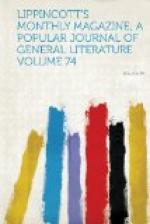[Illustration: Bala.]
There is scarcely an English brook that has not some historical associations, some poetical reminiscences, some attractions beyond those of scenery. Wherever water, forest and meadow were combined, an abbey was generally planted. Bala Lake, with its fishing-rights, once belonged to the Cistercian abbey of Basingwerk, while the Dee just above Llangollen was the property of the abbey of Valle Crucis, whose beautiful ruins still stand on its banks. Before we reach them we pass by the country of the Welsh hero, Owen Glendower, from whom are descended many of the families of this neighborhood and others—the Vaughans, for instance; by Glendower’s prison at Corwen, and the Parliament House at Dolgelly, where he signed a treaty with France, and where the beautiful oak carving of the roof would alone repay a visitor for his trouble in getting there. The Dee is for the most part wanting in striking natural features, but here and there steep rocks enclose its foaming waters; deep banks covered with trees break the rugged shore-line; a village, such as Llanderfel with a tumbledown bridge, lies nestled in the valley; and coracles shoot here and there over the stream. These primitive boats, basketwork covered with hides, or, as used now, canvas coated with tar, are propelled by a paddle, and are much used for netting salmon. Near Bangor the fishermen are so skilful that they generally win in the coracle-races got up periodically by enthusiastic revivalists of old national sports.
[Illustration: Remains of Valle Crucis abbey.]
Llangollen Vale has a beauty of its own, the family likeness of which to that of all valleys in the hearts of mountains makes it none the less welcome. The picturesqueness of thatched houses and a dilapidation of masonry which only age makes beautiful marks the difference between this valley and the Alpine ones with their trim, clean toy houses, or the Transatlantic ones with their square, solid, black log huts and huge well-sweeps; otherwise the fresh greenery, the purple mountain-shadows, the subdued sounds, no one knows whence, the sense of peace and solitude, are akin to every other beautiful valley-scene of mingled wildness and cultivation. A traveller can hardly help making comparisons, yet much escapes him of the peculiar charm that hangs round every place, and is too subtle to disclose itself to the eye of a mere passer. You must live at least six months in one place before its true character unfolds: the broad beauties you see at once, but it needs the microscope of habit to find out the rarest charms. Therefore it is much easier to descant on the tangible, striking beauty of Valle Crucis Abbey than on the aggregate loveliness of Llangollen Vale; and perhaps it is this lack of familiarity that leads novelists, poets and others to dwell so much more and with such detail on buildings than on natural scenery. It may not be given them




